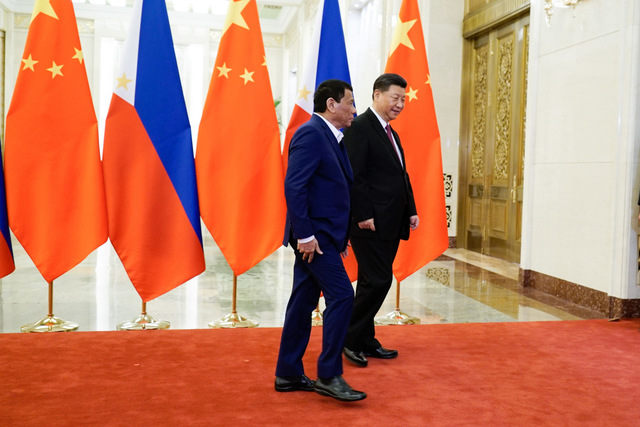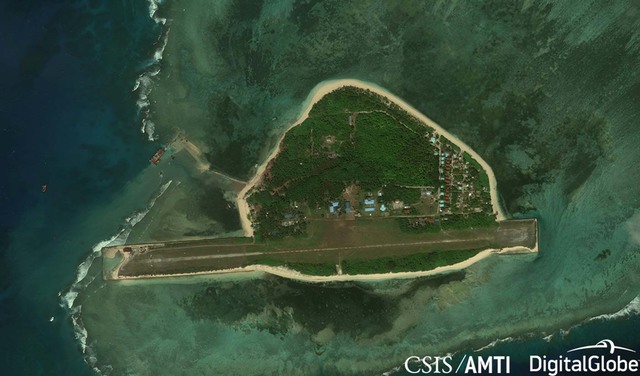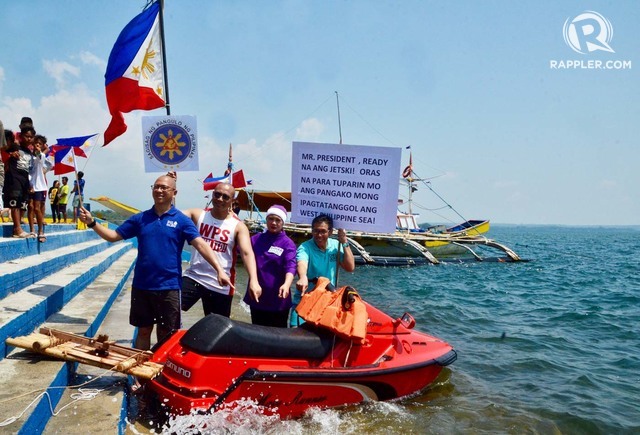President Rodrigo Duterte's stronger words on the sea dispute so far revolve around one specific part of the West Philippine Sea – Pag-asa Island. Here's why it's special to him.
From his usual placating tone, he has threatened to send Filipino soldiers on a “suicide mission” to protect an island that had been swarmed by Chinese ships over several months.
“The Pag-asa Island belongs to us…Hindi ako papayag kung pati Pag-asa i-occupy nila (I won’t allow it if they occupy even Pag-asa),” said Duterte on April 4, from Puerto Princesa City in Palawan.
What could be behind the strong words? And what’s prompting Duterte to speak in such a tone now?
There are key things to note about Duterte’s recent West Philippine Sea remarks. First, they revolve around one specific part of the West Philippine Sea – Pag-asa Island (known as Thitu internationally).
When Duterte brought up the maritime dispute with Xi during their meeting on Thursday, April 25, it was Pag-asa Island he mentioned specifically.

TALKING THINGS THROUGH. President Rodrigo Duterte and Chinese President Xi Jinping walk to the hall where they will hold a bilateral meeting on April 25, 2019. Malacañang photo
The last time Duterte seriously ruffled Chinese feathers was in April 2017, and it also had to do with Pag-asa.
Back then, he had ordered the military to fortify Pag-asa Island, and all Philippine-held islands in the West Philippine Sea.
In the same speech (notably also delivered in Puerto Princesa, a boat ride away from Pag-asa), Duterte said he would even visit Pag-asa Island on Philippine Independence Day. The Chinese were not happy, prompting Duterte to renege on the promise a few days later.
But he didn't stop there. He allowed Defense Secretary Delfin Lorenzana to make the visit, which China tried to stop too. Feet planted firmly on land China claims is theirs, Lorenzana and Filipino soldiers sang the Philippine national anthem proudly.
Clearly, when it comes to Pag-asa, Duterte takes a tougher stance.
Pag-asa vs Panatag
One just needs to compare his vow to protect Pag-asa with his defeatism when it comes to that other famous West Philippine Sea feature, Panatag (Scarborough) Shoal.
“We cannot stop China from doing [these] things,” said Duterte when asked what he would do about a Chinese mayor’s plan to put up a environmental monitoring station on the shoal.
He had also once said: "Huwag na muna natin pakialaman 'yang Scarborough [Shoal] kasi hindi natin kaya eh. Magalit man tayo, hangin lang.”
(Let's not dwell on Scarborough Shoal because we don't have the capabilities. Even if we express anger, it will just amount to nothing.)
Compare this to how he reacted when China blasted as "illegal" the repairs he ordered on Pag-asa Island facilities.
"That's part of our duty as a nation," Duterte parried in 2017, even advising China to just "look away." In the same breath, he reminded China that Filipinos have occupied Pag-asa since 1974.
So while Duterte's recent declarations on the sea dispute are stronger than usual, they are actually consistent with his previous remarks specifically about Pag-asa.
Why is Pag-asa worth making uncompromising statements for? Pag-asa has something that Panatag Shoal, Mischief Reef, Ayungin Shoal, and other talked-about features don’t – a commnunity of Filipino civilians actually living on it.
(READ: The residents of Pag-asa: Life on a disputed island)
Pag-asa is home to around a hundred civilian Filipinos. It has a municipal hall and health center. While China believes the island belongs to them, so far the Philippines has managed to hold on to it, and Duterte wants to keep it that way.
Justice Secretary Menardo Guevarra, who was a high-ranking official in Malacañang at the time Duterte ordered Pag-asa Island repairs, said the President differentiates the island from other parts of the West Philippine Sea.
Duterte appears to adopt a “more flexible approach” when it comes to features where the Philippines’ exclusive rights to use resources is the main issue, the Cabinet member told Rappler.
“But when we speak of Pag-asa Island, which is actually occupied by a Filipino community, we are treading on issues of territory and security,” said Guevarra.
“The President’s tough stance in this regard indicates that his clear priority is on human lives and territorial integrity, which, unlike fishing rights and other economic privileges, are non-negotiable,” he added.

PAG-ASA ISLAND. Philippine construction on Pag-asa Island provokes a paramilitary response from China. Photos courtesy of CSIS/AMTI/DigitalGlobe
This way of thinking may not sit well with maritime law experts. All islands and features within the West Philippine Sea deserve to be protected with the same tough rhetoric, whether occupied or not, because any encroachment violates the country’s sovereign rights.
But Duterte may not think this way. Occupation of Pag-asa by the Chinese crosses one of his red lines: physical harm to Filipinos.
“I assure you, if they kill or arrest people there who are Filipino then that would be the time when we would decide on what to do,” he had said on April 4.
So why deliver such strong remarks against China over Pag-asa now?
Days earlier, the military’s Western Command (Wescom) reported the presence of 275 Chinese ships near Pag-asa Island from January to March this year.
They recorded over 600 incidents of trespassing during these months. The Department of Foreign Affairs slammed them as part of China’s “swarming” tactics.
The presence of Chinese ships around the island began escalating as the Philippines started repairs of Pag-asa facilities, specifically a beaching ramp that is supposed to enable the delivery of construction materials and equipment needed to upgrade, among others, a dilapidated runway.
The beaching ramp was supposed to be finished in early 2019, Lorenzana had said.
But Philippine Ambassador to China Chito Sta Romana doesn’t think the Chinese ships mean to invade Pag-asa Island. So far, they have not intercepted any supply lines to the island, a crucial area of agreement between Beijing and the Duterte administration.
“The areas of agreement are the access lines, the supply lines. You know, that’s why we’re able to continue our construction in Pag-asa, and there has been no effort [to intercept]. If there is any interdiction, that would be a major issue,” he told reporters on Wednesday, April 24, in Beijing.
So why are the Chinese ships there?
“They’re watching Sandy Cay,” said Sta Romana.
The Sandy Cay element
Sandy Cay is a string of sandbars only 3 nautical miles from Pag-asa Island. It’s in the middle of the island and Subi (Zamora) Reef, which China has turned into an artificial island with military capability.
Why is Sandy Cay special to China? Sandy Cay is a naturally-formed feature that only recently became permanently visible above the water surface. Previously, it could only be seen during low tide but deposits from China’s illegal dredging in Subi Reef elevated it in 2017.
China covets Sandy Cay because it could generate a new 12-nautical-mile swathe of territorial waters, said Supreme Court Senior Associate Justice Antonio Carpio.
Because Subi Reef lies within that 12-nm area, China, by controlling Sandy Cay, would legitimize its claim over their man-made island.
But do you hear Duterte threatening suicide missions to protect Sandy Cay? Quite the opposite.
When Chinese ships were spotted near it back in August 2017, Duterte retorted, “Why should I defend a sandbar and kill the Filipinos because of a sandbar?”
That month, when the military tried to construct a nipa hut on Sandy Cay as “shelter” for Filipino fishermen, Duterte called it off, citing an agreement with China that neither side build anything on the sandbars.
If Duterte feels he can afford to be softer on China when it comes to their island-building, he draws the line when it comes to physical harm to Filipinos.
This could explain his other strong remarks against China in the past – his appeal to them to “temper” their radio warnings to Filipino Air Force pilots and his serious concern over the safety of Navy soldiers harassed by a Chinese chopper on the way to Ayungin Shoal.
Elections, U.S. promise
Other factors that make Duterte’s strong remarks on Pag-asa Island significant is that they were made weeks before the May 13 elections and after US Secretary of State Mike Pompeo affirmed that America would act on China aggression in the West Philippine Sea.
Surveys show most Filipinos don’t agree with Duterte’s soft stance on the West Philippine Sea and don’t trust China as much as the US and Japan.
Though Duterte remains popular despite his accomodation of China, he knows the opposition capitalize on the unpopularity of his foreign policy.
He’s labelled ex-foreign secretary Albert del Rosario as among the “yellows,” his term for the Liberal Party which is fielding its own senatorial candidates.
Undoubtedly, Duterte’s amped-up rhetoric looks good on his senatorial bets who can use it to fend off questions about the administration’s pandering to China.

POLITICS. The opposition's senatorial candidates Samira Gutoc, Pilo Hilbay, Gary Alejano, and Chel Diokno hit President Rodrigo Duterte for his soft stance on the West Philippine Sea. Photo by Ben Nabong/Rappler
Could Duterte and the government be gaining confidence to stand up to China from the US’ affirmation of the Mutual Defense Treaty last March?
South China Sea expert Gregory Poling said Pompeo's words are a "clear deterrent" for the Chinese as it sends a message that "violence against Pag-asa (Island) or the (BRP) Sierra Madre (stationed in Ayungin Shoal), for instance, would result in a US response."
Lorenzana gave a rather underwhelming reaction to Pompeo’s remarks.
“He just reiterated what is in the treaty. Nothing of new import,” he had told Rappler back then.
But there’s another question underlying all of Duterte’s surprising public declarations. Does he mean it or is he bluffing?
“From my past experience with him, his position, his public position, you know, that’s what he states also in his discussion,” said Sta Romana.
Duterte government’s red lines
Will Duterte step up his rhetoric against China when it comes to other West Philippine Sea features, like Panatag Shoal?
He might, given that his administration's other red lines specifically involve such features. Bilateral talks between Filipino and Chinese diplomats have led to key agreements that, if violated, could draw a response from the Chief Executive.
According to Sta Romana, who participates in these talks, these crucial agreements are:
- No building on Scarborough Shoal
- Allow Filipino and Chinese fishermen to fish in Scarborough Shoal
- No obstruction of supply and access lines to Pag-asa Island
- No construction or occupation of “new” features like Sandy Cay
The Philippines and China have agreed to these 4, which is why China has not begun reclamation in Scarborough Shoal, why the Philippines continues construction on Pag-asa Island, and why the Philippines stopped building a nipa hut on Sandy Cay.
But the situation in Pag-asa and Sandy Cay is tense because of their proximity to Subi Reef, where China paramilitary ships have congregated and Chinese military planes have landed.
Once a lowly reef, Subi is now an island outfitted with runways, lighthouses, radomes, hangars, and communication facilities. Residents of Pag-asa Island can see the structures on Subi Reef with a naked eye.
“We are occupying one area (Pag-asa Island) and they’re occupying the other feature (Subi Reef) and they are very close to each other and in between is the Sandy Cay. This is really the root of this issue right now,” said Sta Romana.
Duterte and Xi have agreed for their country's diplomats to talk it out. Rappler got no response from Presidential Spokesman Salvador Panelo and Defense Secretary Delfin Lorenzana when we asked if Duterte asked Xi to order Chinese ships to increase their distance from the island.
The vague Palace statement about the meeting also did not mention if Duterte brought up the 2016 Hague ruling, which struck down China’s claim to the West Philippine Sea, including Pag-asa Island.
Some say the ruling could be a powerful galvanizing force for other countries against China – only if the Philippines would use it. Rather than involve the international community though, the Duterte government prefers to dialogue directly with China.
https://www.rappler.com/newsbreak/in-depth/229034-dissecting-duterte-amped-up-west-philippine-sea-rhetoric

No comments:
Post a Comment
Note: Only a member of this blog may post a comment.